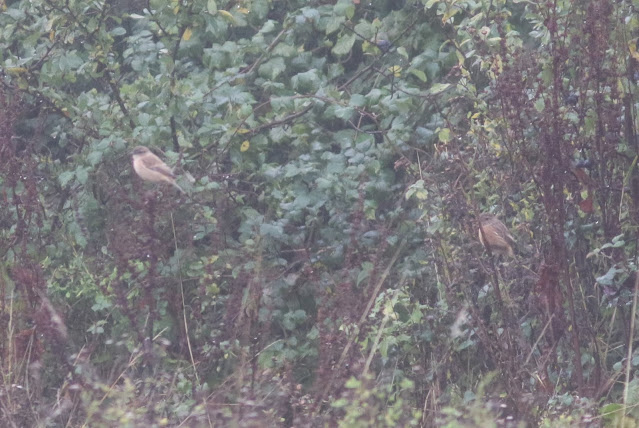In between work today I've been reading and talking about Stonechats inspired by both recent experiences and also Steve Gale found a pale Stonechat on Little Woodcote yesterday evening so I met him there this morning. Steve's full account of that bird HERE which contains some lovely videos and good discussion.
There's certainly a lot of complexity surrounding Stonechat identification and taxonomy. In short, in a vagrant context in the UK there are several taxa to consider including:
a) two 'European Stonechats' -Atlantic Stonechat (hibernans) and Continental Stonechat (rubicola)
b) three 'Eastern Stonechats'- Siberian Stonechat (maurus), Stejneger's Stonechat (Stejnegeri) and Caspian Stonechat (Hemprichii)
According to IOC taxonomy there are three species involved: European Stonechat (including hibernans and rubicola), Siberian Stonechat (maurus and hemprichii) and Stejnegner's Stonechat (stejnegeri).
Atlantic Stonechat (our default resident taxon) is generally richer toned and darker than Continental Stonechat but there is a lot of variation (and intergradation). Continental Stonechat has not officially been recorded in the UK but it is a suspected (but yet unproven) migrant.
Eastern Stonechats differ from European Stonechats in generally having paler rumps, darker underwing coverts and overall paler in all plumages. In first-winter plumage (the most likely plumage a vagrant will be) Siberian Stonechat is peachy toned, with a contrasting white throat, pale wing panel and peachy wrap around rump and clear flanks. Stejneger's Stonechat is generally darker than Siberian overall with a chestnut rump (with 60 percent of birds have streaks on the upper tail coverts) and has a broader bill base. Caspian Stonechat is similar to other Easterns but the critical feature is the white at the base of the tail feathers which in extreme cases can resemble the tail of a Black-eared Wheatear.
The official BBRC line at the moment for the acceptance of either Siberian or Stejneger's is that the plumage and DNA evidence need to support each other with the majority of records being classified as Siberian/Stejneger's (over 400 historical records). Basically DNA evidence is essential to separate the two.
So that's it in a nutshell (for UK - there's more to it but that's all we need to know in a UK context). Here's a few shots of a mix of Stonechats from recent birds and a few other relevant birds that have featured on this blog in the past.











No comments:
Post a Comment